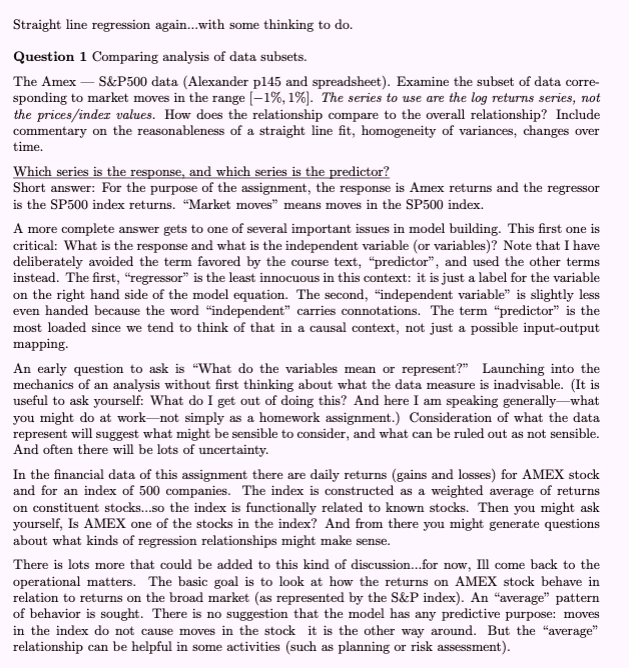Straight line regression again...with some thinking to do. Question 1 Comparing analysis of data subsets. The Amex - S&P500 data (Alexander p145 and spreadsheet). Examine the subset of data corre- sponding to market moves in the range [-1%, 1%). The series to use are the log returns series, not the prices/inder values. How does the relationship compare to the overall relationship? Include commentary on the reasonableness of a straight line fit, homogeneity of variances, changes over time. Which series is the response, and which series is the predictor? Short answer: For the purpose of the assignment, the response is Amex returns and the regressor is the SP500 index returns. "Market moves" means moves in the SP500 index. A more complete answer gets to one of several important issues in model building. This first one is critical: What is the response and what is the independent variable (or variables)? Note that I have deliberately avoided the term favored by the course text, "predictor", and used the other terms instead. The first, "regressor" is the least innocuous in this context: it is just a label for the variable on the right hand side of the model equation. The second, "independent variable" is slightly less even handed because the word "independent" carries connotations. The term "predictor" is the most loaded since we tend to think of that in a causal context, not just a possible input-output mapping. An early question to ask is "What do the variables mean or represent?" Launching into the mechanics of an analysis without first thinking about what the data measure is inadvisable. (It is useful to ask yourself: What do I get out of doing this? And here I am speaking generally-what you might do at work-not simply as a homework assignment.) Consideration of what the data represent will suggest what might be sensible to consider, and what can be ruled out as not sensible. And often there will be lots of uncertainty. In the financial data of this assignment there are daily returns (gains and losses) for AMEX stock and for an index of 500 companies. The index is constructed as a weighted average of returns on constituent stocks...so the index is functionally related to known stocks. Then you might ask yourself, Is AMEX one of the stocks in the index? And from there you might generate questions about what kinds of regression relationships might make sense. There is lots more that could be added to this kind of discussion...for now, Ill come back to the operational matters. The basic goal is to look at how the returns on AMEX stock behave in relation to returns on the broad market (as represented by the S&P index). An "average" pattern of behavior is sought. There is no suggestion that the model has any predictive purpose: moves in the index do not cause moves in the stock it is the other way around. But the "average" relationship can be helpful in some activities (such as planning or risk assessment)







